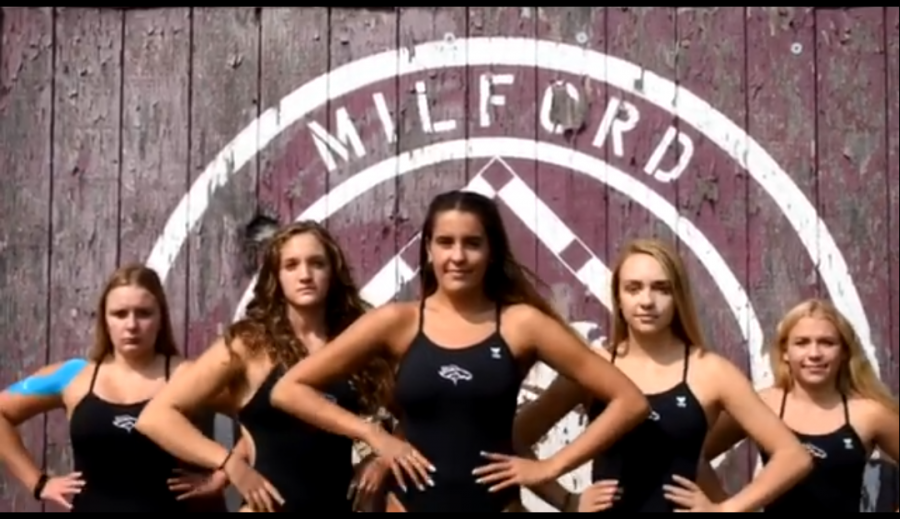Fall athletes given second chance at a season
MHS Girls Swim and Dive seniors suited up for another eventful season in the pool amidst the global pandemic.
September 28, 2020
A return to the classroom also marks the beginning of a new season for many of Milford’s fall athletes. Due to COVID, the prospect of a traditional athletic experience seemed to be dwindling until Governor Whitmer and the MHSAA cleared high schools across the state to partake in a season with modified expectations. Various new guidelines, both general and sport-specific, have been provided to aid coaches and student athletes in the transition toward a safer practice and competition environment. Apprehension has become the new normal as one change after another unfolds; how will fall athletes adapt to these changes and showcase their hard work amidst this pandemic?
Numerous differences have been announced for high school teams to implement, including required health questionnaires, mask-wearing, social distancing, daily temperature checks, inaccessible water for athletes (public drinking fountains and large Gatorade containers have been banned for sanitary purposes), and increasingly self-guided workouts.
The majority of fall athletes had a late start to their season, losing valuable hours or typical practice conditions as high schools statewide awaited a decision.
Other sacrifices have also been made in order to have a season at all. MHS’ Cross Country team, for example, adopted multiple spacing methods to avoid contamination: “We have 4 different practice times to minimize exposure among the team,” Coach Brian Salyers shared. “We have ‘Pods’ of 4-8 student athletes within each practice session during each segment of practice.” For the same reasons, locker room availability is limited to bathroom usage only–athletes must change at home and leave the premises at the conclusion of practice.
Coaches will face new challenges this season to match the unprecedented athletic atmosphere that will become the temporary “normal” for students. Swim Coach James Schuler understands how the effects of normal struggles for student athletes may be amplified by an altered training space: “As a coach, my challenges will be making sure I set an excellent example in regards to safety and paying close attention to how my student athletes are doing from a physical health perspective but also mentally.” He elaborated; “Normal seasons are at times a little mentally challenging and I know that having a complex school schedule this year and some changes to ‘normal’ will only complicate that. Our training schedule will be a little different given the challenges of COVID and so as a coach, I will need to be doing consistent checks and updates as needed to ensure we are on the right track.” Coaches embracing these changes as a learning opportunity will further encourage athletes to persevere and be grateful for extended training options. “We need to find the good in the opportunity to be active, around peers, and competition,” Salyers stated. “Embrace the opportunity, knowing the season is a gift.”
The biggest obstacle most high school athletic associations face is how competitions will occur. Outdoor sports allow two fans to attend per athlete, and indoor competitions will allow a certain percentage of occupancy to be fulfilled, including the athletes, coaches, and event aids. This means that far fewer people will be able to attend these sporting events in-person. Regarding swimming, Schuler offers broadcasting meets and is encouraging parents to volunteer as on-deck timers as two viable solutions to increase viewer involvement. Considering football games alone, which bring in hundreds of community members, the situation doesn’t allow for many fans to be there in-person, as explained by MHS Varsity Football Coach Garfrey Smith. The reasons for such limited capacity–indoor or outdoor–aligns with state and local restrictions, and likely will not dissolve for the sake of larger competitions; no invitationals, no out-of-conference dual meets, and few larger meets will happen in an attempt to best decide who is necessary in the vicinity.
Above all else, everyone must prioritize being responsible in and out of practice for the sake of teammates and the community. If students fail to effectively partake in safety precautions, life without sports at MHS may become a reality–community well-being comes first. Recognizing this truth, Smith explained that the football team has decided they “Have adapted and are ready to play. Different team with a different attitude. We are All in.” Students, families, and staff must be flexible and willing to experiment during a time where very little is solidified–stressing over the uncontrollable will hinder performance and positivity. “A lot is going on in the world that is not within each individual person’s control, and at times it can get overwhelming thinking about those things. Focus on what you can control,” Schuler expressed. “At the end of the day, the success of all of our sports depends on each student athlete’s ability to keep themself and by extension their teammates healthy and safe. That is the biggest win we can have this fall, keeping everyone healthy, and each student athlete at Milford is part of that team.”
